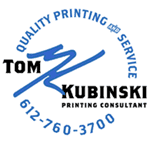  Tom Kubinski www.shapco.com
| January 2004 TK's KornerPDF Info and Quark vs. InDesign As you know, creative professionals face a number of challenges. First, in the course of preparing documents for print publishing, they have to routinely manage projects with tight deadlines and small budgets. This is especially true since the rise of the Internet, which has increased the pressure to produce content in a timely, cost-effective way. The Internet has also affected how creative professionals work in that they're expected to be able to share documents with clients and colleagues under any circumstances. This means exchanging files with peers who may be using a different computer platform and who may be across town or across the ocean. Typically, this is done by emailing files or posting them to an FTP site, but sharing files electronically entails two "sub" challenges, First, graphic professionals need a compact file format, and second, they need a file format that maintains a designed document's visual integrity. Review and approval cycles are also challenging for creative professionals. Receiving feedback and appropriate sign-offs can take time, and these processes require close attention to prevent miscommunication and the introduction of potentially costly mistakes. And when the hurdles of communicating with clients and peers have been overcome, and documents have been reviewed and approved, creative professionals have to prepare their files for the printer. That means handing off a file or files that you know will print exactly as you intended. Native application files entail their own set of risks. For one thing, they're large, which can bog down telecommunications bandwidth, but more importantly, if the recipient doesn't have the same version of the same application on the same platform that you used to create the file, he or she may not be able to open it. Worse yet, they may end up unintentionally changing the document when they open it-if, say, you forget to send the fonts and they have to substitute different typefaces. This can cause delays and creates an opportunity for errors to be introduced into the file. And when application files are sent to printers and they're missing essential elements or are poorly constructed, the job may be delayed or printed incorrectly. Those are expensive setbacks. The answer Adobe Acrobat with over 200 million copies of Acrobat Reader distributed worldwide, Adobe Portable Document Format (PDF) is standard for electronic document distribution worldwide. Adobe PDF is a universal file format that preserves the exact look and feel of any source document, including all of the fonts, formatting, colors, and graphics, regardless of the application and platform used to create it. Adobe PDF files can be opened reliably across a broad range of hardware and software with the free Adobe Acrobat Reader? software. You can convert any electronic document or Web page to Adobe PDF using Adobe Acrobat 6.0 software, and any scanned page to searchable Adobe PDF using Adobe Acrobat Capture 3.0 software. Adobe PDF is a standard on the World Wide Web and is also used to distribute electronic documents over corporate networks, via e-mail, and on CD-ROM. Many corporations, educational institutions, and government agencies use Adobe PDF to distribute documents to the public or to groups within their organizations and Adobe PDF is also the emerging workflow standard in the publishing industry. Adobe PDF is also gaining tremendous popularity as the basis for new e-business and e-government processes. Its support for electronic forms, digital signatures, password security, and electronic mark-ups make it the ideal platform for converting yesterday's paper-based business processes to fully inter-active digital processes. By choosing one of the six settings: Standard, Smallest File Size, High Quality, Press Quality, PDFX1a, or PDFX3a you can create a PDF for any situation. PDF resources
"The PDF not only eliminated our reliance on expensive couriers, it allowed us to present our designs in a digital format that our PC-using clients could view right on their computer screens. With PDFS we've been able to shorten the concept to print timetable and handle many rush projects that would have been impossible 5 years ago."
QuarkXPress 6 vs. InDesign 2 The question I hear most often these days is "Which is better: QuarkXPress 6 or InDesign 2?" Of course, while everyone wants a definitive answer, any honest reviewer must respond: "It depends." It depends on who you are, what your workflow is, and what you need to accomplish in your work. That said, I will make one (more or less) definitive statement: Comparing the two programs in a vacuum, all things being equal, it is quite clear that Adobe InDesign is the superior program. It incorporates superior technology, is written using a superior programming methodology, the features it has in common with XPress are implemented in a superior way, and while XPress has a few important features that InDesign does not, InDesign clearly has the superior feature set in toto. However, that doesn't mean you should immediately switch to InDesign. For the more complex answer, read on. It's good stuff and well worth a read.
Referrals are greatly appreciated. If you know someone who I should contact, please let me know.
If you would like to join me on one of our upcoming tours, if there is something that you would like me to address, or if you know of someone who might like to receive TK's Korner, please let me know via e-mail at TKubinski@shapco.com Successfully, |

